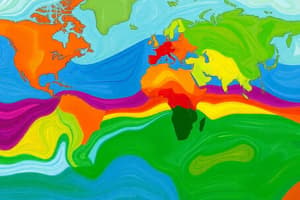Podcast
Questions and Answers
What is the Köppen Climate Classification System based on?
What is the Köppen Climate Classification System based on?
- Humidity levels alone
- Both temperature and precipitation data (correct)
- Mean monthly and annual values of temperature
- Mean monthly and annual values of precipitation
Which of the following are the principal groups in the Köppen system? (Select all that apply)
Which of the following are the principal groups in the Köppen system? (Select all that apply)
- Highland Climates (correct)
- Humid Tropical Climates (correct)
- Polar Climates (correct)
- Desert Climates
The Köppen climate classification system uses _____ to classify climates.
The Köppen climate classification system uses _____ to classify climates.
temperature and precipitation data
What is the main difference between wet tropical climates and tropical wet and dry climates?
What is the main difference between wet tropical climates and tropical wet and dry climates?
What is characteristic of humid tropical climates?
What is characteristic of humid tropical climates?
Which climate is known for having distinct periods of low precipitation?
Which climate is known for having distinct periods of low precipitation?
What type of climates do coastal areas between 40° and 65° latitude have?
What type of climates do coastal areas between 40° and 65° latitude have?
Regions with dry-summer subtropical climates have a strong winter __________ maximum.
Regions with dry-summer subtropical climates have a strong winter __________ maximum.
Where is the dry-summer subtropical climate found in the United States?
Where is the dry-summer subtropical climate found in the United States?
Flashcards are hidden until you start studying
Study Notes
Köppen Climate Classification System
- A prominent system for classifying world climates using mean monthly and annual temperature and precipitation values.
- Effectively categorizes the globe into realistic climatic regions.
Five Principal Groups
- Five main climate groups:
- Humid tropical climates
- Dry climates
- Humid mid-latitude climates
- Polar climates
- Highland climates
- Polar climates exemplify extreme temperature conditions.
- Dry climates are unique due to their classification based on precipitation levels.
- Each of the main groups is subdivided into further specific classifications.
Humid Tropical Climates
- Characterized by no winters; every month averages above 18°C.
- Annual precipitation can surpass 200 centimeters.
- Consists of two varieties: wet tropical and tropical wet and dry climates.
Wet Tropical Climates
- Exhibits high temperatures and significant annual rainfall, influenced by intense solar radiation.
- Warm, humid air rises, cools, condenses, and precipitates, fostering tropical rainforests.
Tropical Wet and Dry Climates
- Features distinct wet and dry seasons, although overall temperature and precipitation resemble wet tropical climates.
- Dominated by savannas, tropical grasslands with drought-resistant trees.
Difference Between Wet Tropical and Tropical Wet and Dry
- The primary distinction lies in the distribution of annual precipitation, with wet tropics receiving consistent rainfall.
Humid Mid-Latitude Climates
- Encompasses climates with either mild or severe winters.
- Mild winter climates have average temperatures between -3°C and 18°C during the coldest month.
- Severe winter climates have average temperatures below -3°C in the coldest month.
Types of Humid Mid-Latitude Climates
- Humid subtropical climates are prevalent between 25° and 40° latitude, particularly in the southeastern United States.
- Experiences hot summers and mild winters with occasional frosts during the cold months.
Marine West Coast Climate
- Coastal regions between 40° and 65° latitudes experience mild winters and cool summers due to maritime air.
- North America's marine west coast climate stretches from northern California to southern Alaska, with a narrow temperature range of 13 degrees.
Dry Summer Subtropical Climate
- Found between 30° and 45° latitude, this climate is marked by a strong winter rainfall maximum.
- In the U.S., predominantly located in California.
Studying That Suits You
Use AI to generate personalized quizzes and flashcards to suit your learning preferences.




